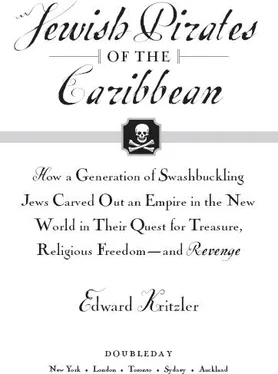Edward Kritzler - Jewish Pirates of the Caribbean
Здесь есть возможность читать онлайн «Edward Kritzler - Jewish Pirates of the Caribbean» весь текст электронной книги совершенно бесплатно (целиком полную версию без сокращений). В некоторых случаях можно слушать аудио, скачать через торрент в формате fb2 и присутствует краткое содержание. Год выпуска: 2008, ISBN: 2008, Издательство: Knopf Doubleday Publishing Group, Жанр: Старинная литература, на английском языке. Описание произведения, (предисловие) а так же отзывы посетителей доступны на портале библиотеки ЛибКат.
- Название:Jewish Pirates of the Caribbean
- Автор:
- Издательство:Knopf Doubleday Publishing Group
- Жанр:
- Год:2008
- ISBN:9780385528368
- Рейтинг книги:3 / 5. Голосов: 1
-
Избранное:Добавить в избранное
- Отзывы:
-
Ваша оценка:
- 60
- 1
- 2
- 3
- 4
- 5
Jewish Pirates of the Caribbean: краткое содержание, описание и аннотация
Предлагаем к чтению аннотацию, описание, краткое содержание или предисловие (зависит от того, что написал сам автор книги «Jewish Pirates of the Caribbean»). Если вы не нашли необходимую информацию о книге — напишите в комментариях, мы постараемся отыскать её.
Jewish Pirates of the Caribbean — читать онлайн бесплатно полную книгу (весь текст) целиком
Ниже представлен текст книги, разбитый по страницам. Система сохранения места последней прочитанной страницы, позволяет с удобством читать онлайн бесплатно книгу «Jewish Pirates of the Caribbean», без необходимости каждый раз заново искать на чём Вы остановились. Поставьте закладку, и сможете в любой момент перейти на страницу, на которой закончили чтение.
Интервал:
Закладка:
29. Seymour B. Liebman, The Jews in New Spain (Miami: University of Miami Press, 1970), 46.
30. Judah Gribetz, Edward L. Greenstein, and Regina Stein, The Timetables of Jewish History: A Chronology of the Most Important People and Events in Jewish History (New York: Simon and Schuster, 1993), 162.
31. Liebman, The Jews in New Spain, 46, quotes Spanish historian Salvador de Madariaga: After 1,500 years on the Iberian Peninsula, Sephardim were as much Spanish as Jewish: “The Jews of the Expulsion left behind a deeply judaized Spain, and went abroad no less Hispanified.”
Chapter Three: The King’s Essential Heretics
1. Frank Cundall and Joseph Pietersz, Jamaica Under the Spaniards, abstracted from the Archives of Seville (Kingston: Institute of Jamaica, 1919), 10–11.
2. Ruth Pike, Enterprise and Adventure: The Genoese in Seville and the Opening of the New World (Ithaca, N.Y.: Cornell University Press, 1966), 60, 89: In the 1530s, the Genoese were licensed to procure African slaves “to supply the needs of the expanding sugar industry on the islands,” and in 1535 transported a thousand slaves. Nowhere is it reported that Portuguese were sent. Irene Wright, “Sugar Industry in the Americas,” American Antiquity 21 (1916), 755–82; Irene Wright, “The History of the Early Sugar Industry in the West Indies from Documents of the Archives of the West Indies in Seville,” Louisiana Planter and Sugar Manufacturer Journal 54 (1915), 14–15: In 1527, New Seville’s sugar mill is described as “a good one, producing good sugar.”
3. Alexandre Herculano, History of the Origin and Establishment of the Inquisition in Portugal, vol. 1, trans. John C. Branner (New York: AMS Press, 1968), 376–78, 380–81: A further indication that Manzuelo’s request for “Portuguese” settlers was for Spanish conversos is the fact that in 1534, when Charles received the communiqué, Portugal’s New Christians were not allowed to emigrate. From 1532 to 1536, Portugal’s king had reversed his policy that for a price permitted conversos to settle his colonies.
4. J. H. Elliott, Imperial Spain: 1469–1716 (London: Penguin, 1963), 52–53.
5. Laredo is Spain’s port on the Bay of Biscay. Hayward Keniston, Francisco de los Corbos, Secretary of the Emperor Charles V (Pittsburgh: University of Pittsburgh Press, 1960), 161: “It was rumored that they were offering 50 ducats for each pregnancy with boy babies to remain in Spain and girls to return with them to Amazonia.”
6. Dudley Pope, The Buccaneer King: The Biography of the Notorious Sir Henry Morgan, 1635–1688 (New York: Dodd, Mead, 1978), 29–30: Charles’s average of 3.5 tons of gold each year was equal to the amount the queen of Sheba gave Solomon. In the sixteenth century, Spaniards “found, looted or mined three times the amount of gold and silver which had been in circulation” before Columbus sailed.
7. Antonio Dominguez Ortiz, The Golden Age of Spain, 1516–1659 (New York: Basic Books, 1971), 47: Jacob Fugger loaned him half of the one-million-florin cost of the election.
8. Germán Arciniegas, Caribbean Sea of the New World (New York: Alfred A. Knopf, 1946), 118–21; Henry Cruse Murphy, The Voyage of Verrazzano: A Chapter in the Early History of Maritime Discovery in America (New York, 1875): an appendix includes letters to Charles informing him of Verrazano’s deed and continued threat.
9. C. H. Haring, The Buccaneers in the West Indies in the XVII Century (Hamden, Conn.: Archon Books, 1966; reprint of 1910 edition), 30; Arciniegas, Caribbean Sea of the New World, 118.
10. “Correspondence and Itinerary of Charles V,” ed. William Bradford (London: Bently Publishers, August 31, 1850), 439, 367.
11. Miriam Bodian, Hebrews of the Portuguese Nation, Conversos and Community in Early Modern Amsterdam (Bloomington, Ind.: Indiana University Press, 1997), 11. In 1391, hundreds of thousands of Jews of Spain were forcibly converted or sentenced to death. “This huge influx of New Christians exacerbated social and racial suspicions and eventually led to what would become known as Toledo’s limpieza de sangre or ‘purity of blood’ statutes of 1449 to limit the rights of the new class of Christians. Those who maintained Jewish blood or lineage deriving from Jewish ancestry were classed as ‘impure’ and excluded from positions of power and prestige, and universities. These laws were applied in Seville in 1515, and Santo Domingo in 1525.”
12. William B. Goodwin, Spanish and English Ruins in Jamaica (Boston: Meador Publishing Co., 1938),
13: “[Jewish] descendants of these Portuguese settlers are found in many parts of the island today.” 13. On July 14, 1534, the sultan’s cavalry of fifty thousand horsemen conquered Tabriz in northern Persia, but rather than moving on to threaten Charles’s eastern empire instead turned east and captured Baghdad that October.
14. Neil Grant, Barbarossa, the Pirate King (New York: Hawthorn Books, 1972), 8–9: The bulky ships of Spain and Genoa were easily outmaneuvered by the corsairs’ galley, a long, slender vessel, driven by massive oars with one main triangular sail called a lateen. The pirates would attack an enemy ship by ramming it with its iron bow (resembling a long beak). The corsairs then leaped on board and a hand-to-hand fight would ensue.
15. Ortiz, The Golden Age of Spain, 52–58.
16. Sir Godfrey Fisher, Barbary Legend (Oxford, U.K.: Clarendon Press, 1957), 55: Barbarossa as “General of the Sea” rarely left the land—his functions as admiral were primarily administration and “his naval duties were performed by a lieutenant, until later in the century they were entrusted to a separate officer [Sinan] who, as the local Captain of the Sea, [was] directly responsible to the sultan.”
17. Samuel Tolkowsky, They Took to the Sea (London: Thomas Yoseloff, 1964), 174: On August 16, 1533, Henry VIII’s ambassador in Rome informed his king that a few days earlier “the famous Jewish pirate” was cruising with a strong Turkish fleet of sixty ships off the southern coast of Greece to attack the Spanish fleet defending the western Mediterranean; J. S. Brewer, J. Gairdner, and R. H. Brodie, eds., Letters and Papers, Foreign and Domestic, of the Reign of Henry VIII (London, 1862–1932), vol. 6, 427: Sinan was referred to in 1528 by the Portuguese governor in India as “the great Jew,” who he mistakenly thought had been sent by Suleiman to assist the king of Calicut to fight the Portuguese; Benjamin Arbel, Trading Nations: Jews and Venetians in the Early Modern Eastern Mediterranean (New York: E. J. Brill, 1995), 181, lists many Venetian sources from 1530 that refer to Sinan as “the Jew.”
18. “Correspondence and Itinerary of Charles V,” 349.
19. Keniston, Francisco de los Corbos, 170.
20. E. Hamilton Currey, Sea Wolves of the Mediterranean: The Grand Period of the Moslem Corsairs (New York: Frederick A. Stokes Company, 1914), 108.
21. “Correspondence and Itinerary of Charles V,” 358–59: Charles’s unshakable courage is epitomized in one of his later battles, when, gout having immobilized his neck and made his feet lame, he had himself tied to his horse and galloped into the heart of the thickest action. Grant, Barbarossa, 46–48; Currey, Sea Wolves of the Mediterranean, 107–9.
22. H. Z. (J. W.) Hirschberg, A History of the Jews of North Africa, vol. 2, ed. Eliezer Bashan and Robert Attal (Leiden: E. J. Brill, 1981), 480, quotes the contemporary historian R. Josef Ha-Kohen’s account of the aftermath of the battle: “The Jews of whom there were many, in part fled into the desert, hungry, thirsty and completely destitute, and the Arabs plundered everything they brought with them; and many died at that time.”
Читать дальшеИнтервал:
Закладка:
Похожие книги на «Jewish Pirates of the Caribbean»
Представляем Вашему вниманию похожие книги на «Jewish Pirates of the Caribbean» списком для выбора. Мы отобрали схожую по названию и смыслу литературу в надежде предоставить читателям больше вариантов отыскать новые, интересные, ещё непрочитанные произведения.
Обсуждение, отзывы о книге «Jewish Pirates of the Caribbean» и просто собственные мнения читателей. Оставьте ваши комментарии, напишите, что Вы думаете о произведении, его смысле или главных героях. Укажите что конкретно понравилось, а что нет, и почему Вы так считаете.












